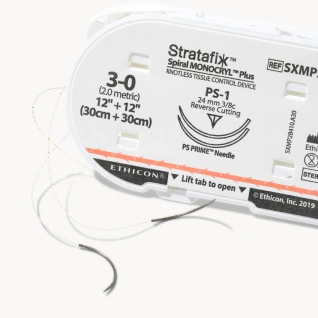Key Messages
- STRATAFIX™ Spiral PDS Plus Knotless Tissue Control Device is paired with premium Ethicon needles that are resistant to bending or breaking and penetrate tissue smoothly.1
- Offers superior penetration performance, requiring less force while maintaining strength.
- Is as strong as V-Loc™ 180 Devices at time zero and provide greater strength retention over time.2-4*†
- Includes antibacterial technology and is the only barbed suture with triclosan which has been shown to help address known risk factors for surgical site infection.5,6 STRATAFIX™ has been shown to exhibit 99.9% fewer bacteria than non-triclosan-coated sutures such as V-LOC™.7,8‡
- This technology aligns with the CDC, ACS/Surgical Infection Society, and NICE guidelines, which recommend triclosan-coated sutures to reduce the risk of SSIs.9-13§¶
- A meta-analysis of 21 randomized controlled trials showed a 28% reduction in SSI risk with the use of triclosan-coated sutures.14||#
- Supports an efficient traditional unidirectional continuous technique or a bidirectional technique, enabling two clinicians to close with a single device with the ability to complete duel or multi-layer closures.
- Increases efficiency by eliminating the need for knot-tying and the related complications.15,16
- Demonstrated to result in shorter OR time and lower costs.17,18
Detailed Talk Track
References
*In an ex vivo porcine model.
†As demonstrated by 6-week in vitro testing.
‡In vitro studies comparing STRATAFIX™ Spiral MONOCRYL™ Plus vs. QULL™ MONODERM™ and STRATAFIX™ Spiral MONOCRYL™ Plus vs. V-Loc™ 90 using 24-hour incubation with high concentrations of S. aureus.
§CDC, WHO, ACS/SIS, NICE, and KRINKO guidelines on reducing the risk of surgical site infections are general to triclosan-coated sutures and are not specific to any one brand.
¶All triclosan-coated sutures in these RCTs were Ethicon Plus Antibacterial Sutures (MONOCRYL™ Plus, VICRYL™ Plus, and PDS™ Plus).
||In a meta-analysis of 21 RCTs, 6462 patients, 95% CI: (14, 40%), P<0.001
#All triclosan-coated sutures in these RCTs were Ethicon Plus Antibacterial Sutures (MONOCRYL™ Plus, VICRYL™ Plus, and PDS™ Plus)
1. Ethicon Wound Closure Manual 2012. Ethicon, Inc.
2. Nonnenmann H. Performance Testing Report for STRATAFIX Spiral PDS Plus – Mechanical Testing. 100491281-Rev 1. November 17, 2016. Ethicon, Inc.
3. Nawrocki J. Report for Assessment of Benchtop Tissue Holding Strength of STRATFIX Spiral PDS PLUS, STRATAFIX Spiral Monocryl PLUS, V-Loc 90 and V-Loc 180 barbed suture devices. 100559286. July 19, 2017. Ethicon, Inc.
4. Nawrocki J. Report for Assessment of Real Time In-Vitro BSR Testing of STRATAFIX Spiral PDS Plus, STRATAFIX Spiral Monocryl PLUS, V-Loc 90 and V-Loc 180 barbed suture devices. 100552029. July 14, 2017. Ethicon, Inc.
5. Ming X, Rothenburger S, Nichols MM. In vivo and in vitro antibacterial efficacy of PDS Plus (polidioxanone with triclosan) suture. Surg Infect (Larchmt). 2008;9(4):451-457.
6. Ming X, Rothenburger S, Yang D. In vitro antibacterial efficacy of Monocryl Plus Antibacterial Suture (poligelcaprone 25 with triclosan). Surg Infect (Larchmt). 2007;8(2):201-207.
7. Bhende S. Comparative evaluation of bacterial colonization on STRATAFIX™ Spiral MONOCRYL™ Plus Knotless Tissue Control Device vs QUILL MONODERM™ Wound Closure Device using attachment assay and scanning electron microscopy. AST-2020-0090. August 17, 2020. Ethicon, Inc.
8. Bhende S. Study Report: Comparative evaluation of bacterial colonization on STRATAFIX Spiral MONOCRYL Plus Knotless Would Closure Device vs V-LOC 90 Absorbable Wound Closure Device and MONOCRYL knots using an in vitro attachment assay and scanning electron microscopy. October 12, 2018. Ethicon, Inc.
9. Berríos-Torres SI, Umscheid CA, Bratzler DW, et al. Centers for Disease Control and Prevention Guideline for the Prevention of Surgical Site Infection. JAMA Surg. 2017;152(8):784_791.
doi:10.1001_jamasurg. 2017.0904.
10. World Health Organization. Global Guidelines for the Prevention of Surgical Site Infection. https:__apps.who.int_iris_bitstream_handle_10665_250680_9789241549882-eng.pdf?sequence=8. Published November 2016. Accessed August 24, 2023
11. Ban KA, Minei JP, Laronga C, et al. American College of Surgeons and Surgical Infection Society:
Surgical Site Infection Guidelines, 2016 Update. J Am Coll Surg. 2016;224(1):59_74.
12. National Institute for Health and Care Excellence (NICE) Guideline. Surgical site infections: prevention and treatment. NICE website. https:__www.nice.org.uk_guidance_ng125_chapter_Recommendations#closuremethods. Accessed August 24, 2023.
13. Prevention of postoperative wound infections. Recommendation of the Committee for Hospital Hygiene and Infection Prevention (KRINKO) at the Robert Koch Institute. Bundesgesundheitsbl. 2018; 61(4):448_473
14. de Jonge SW, Atema JJ, Solomkin JS, Boermeester MA. Meta-analysis and trial sequential analysis of triclosan-coated sutures for the prevention of surgical site infection. Brit J Surg. 2017;ePub-DOI: 10.1002_bjs.10445.
15. Einarsson JI, Chavan NR, Suzuki Y, Jonsdottir G, Vellinga TT, Greenberg JA. Use of bidirectional barbed suture in laparoscopic myomectomy: evaluation of perioperative outcomes, safety, and efficacy. J Minim Invasive Gynecol. 2011;18(1):92-95.
16. Warner JP, Gutowski KA. Abdominoplasty with progressive tension closure using a barbed suture technique. Aesthet Surg J. 2009;29(3):221-225.
17. Johnston SS, Chen BP, Tommaselli GA, Jain S, Pracyk JB: Barbed and conventional sutures in spinal surgery patients: an economic and clinical outcomes comparison. J Wound Care 2020, 29(Sup5a):S9-s20.
18. Peleg D, Ahmad RS, Warsof SL, et al. A randomized clinical trial of knotless barbed suture vs conventional suture for closure of the uterine incision at cesarean deliver.Am J Obstet Gynecol. 2018;218(3):343.e1-343.e7.
CONFIDENTIAL. FOR INTERNAL USE ONLY. NOT FOR USE WITH ANY CUSTOMER OR FOR EXTERNAL DISTRIBUTION.
